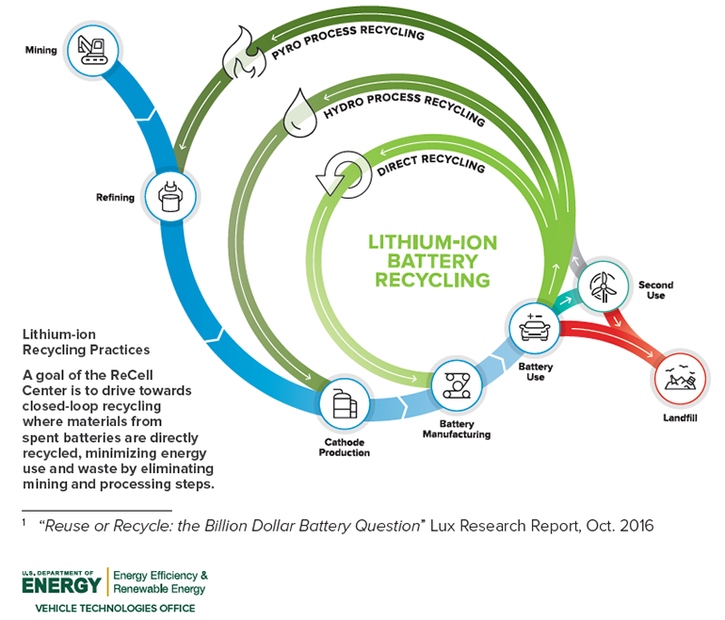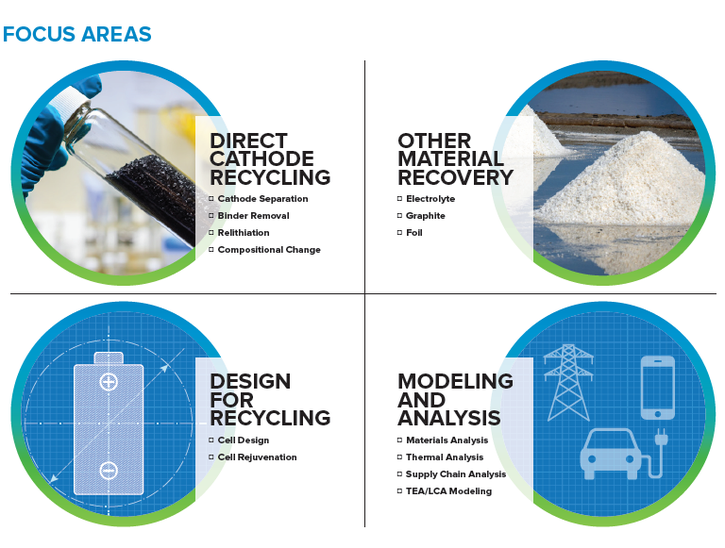New Processing, Design Technologies to Improve Battery Recycling
The ReCell Center is developing techniques to extract maximum value from current and future battery chemistries at end of life.
The ReCell Center, the Department of Energy’s first advanced battery recycling research and development (R&D) center, will develop cost-effective, flexible processing techniques to extract maximum value from current and future battery chemistries at end of life.
The ReCell Center is located at Argonne National Laboratory and incorporates access to experts and novel R&D facilities from the National Renewable Energy Laboratory (NREL), Oak Ridge National Laboratory (ORNL), Michigan Technological University, University of California San Diego and Worcester Polytechnic Institute.
By 2020, industry leaders estimate lithium-ion battery recycling in the U.S. could become a $2 billion market. But only if key technical challenges to be addressed by the center, such as materials cost reduction and materials availability, are overcome.

The ReCell Center is leveraging national experts from academia and national laboratories to derisk lithium-ion recycling by developing state-of-the-art techniques that will make battery recycling cost effective.
A combination of new separation and processing techniques along with new cell designs will enable the capture of more constituents and higher-value materials. These recycled materials can be used in new batteries, reducing production costs by 10 to 30 percent, helping to bring down the overall cost of electric vehicle batteries to the Department of Energy’s goal of $80 per kilowatt hour. The most promising new recycling techniques and battery designs will be demonstrated at pilot scale at the ReCell Center and licensed to industry for commercialization.
The ReCell Center will reduce the risk-to-reward ratio industry faces in expanding lithium-ion recycling programs by demonstrating a scalable process based on the following direct recycling principles.

Direct Cathode Recycling: Current lithium-ion recycling methods, such as hydrometallurgical and pyrometallurgical processes, only enable the recovery of lower-value metal salts that need to be processed back into battery materials. Direct recycling will enable recovery of higher-value cathode materials in a condition suitable for direct re-entry into lithium-ion battery production, providing a lower-cost alternative to battery manufacturers.
Other Material Recovery: Developing low-energy and low-cost separation processes that selectively recover other battery materials, such as lithium salts, electrolyte solvents and graphite, will give manufacturers additional products to sell. In addition, waste disposal issues are reduced.
Design for Recycling: New battery designs could enable extended battery life and improved recyclability. The center team will explore new designs for wound, prismatic and pouch cells so they can be rejuvenated. This extends cell life and reduces cost per use. Other design improvements can enable easier disassembly and material separation to decrease recycling costs.
Modeling and Analysis: The use of modeling and analysis tools will help determine the most valuable areas of research and validate R&D.
About the Author(s)
You May Also Like


